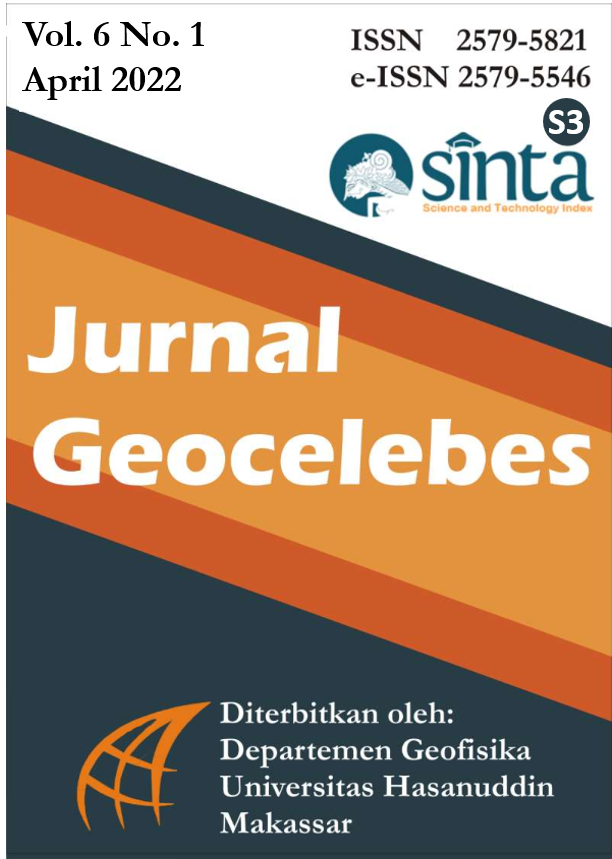Classification of Majene Regency Landslide Prone Areas Using Geographic Information System and Storie Index
Klasifikasi Daerah Rawan Tanah Longsor Kabupaten Majene Menggunakan Sistem Informasi Geografis dan Metode Indeks Storie
DOI:
https://doi.org/10.20956/geocelebes.v6i1.19040Keywords:
Geographic Information Systems, landslide, Mamuju-Majene Thrust FaultAbstract
On January 14, 2021, several villages in Majene Regency suffered landslides triggered by a M6.2 earthquake. The study’s aim is to use the Index Storie model approach, remote sensing data, and Geographic Information Systems (GIS) to map the distribution of landslide-prone areas as a mitigation basis in Majene Regency to reduce the potential for future landslide disasters. The level of landslide potential was determined based on slope conditions, soil types, rainfall, land use types, and potential earthquake risk. In general, morphological conditions in Majene Regency are dominated by slopes that are still covered in forests and receive relatively low rainfall, resulting in low landslide potential if seismic potential factors are not taken into account. Based on the results of an analysis that considers slope factors and potential seismic risks, the results of a map that illustrates the risk of landslide are quite high in several areas, are Malunda District, Ulumanda District, and Tubo Sendana District.Downloads
References
Annisa, J., Sutikno, S. and Rinaldi. 2015. Analisis Daerah Rawan Longsor Berbasis Sistem Imformasi Geografis (Studi Kasus : Kabupaten Lima Puluh Kota, Sumatera Barat). JOM FTEKNIK. 2(2), pp.1-8. https://jom.unri.ac.id/index.php/JOMFTEKNIK/article/view/7976
Arifin, S., Carolila, I. and Winarso, C. 2006. Implementasi Penginderaan Jauh dan SIG untuk Inventaris Daerah Rawan Bencana Longsor (Propinsi Lampung). Jurnal Penginderaan Jauh dan Pengolahan Data Citra Digital. 3(1), pp.77-86. http://jurnal.lapan.go.id/index.php/jurnal_inderaja/article/view/501
Bais, R.E., Sunaryo, D.K. and Sai, S.S. 2018. Pemanfaatan Metode Index Storie untuk Prediksi Tingkat Kerentanan Gerakan Tanah dengan Memanfaatkan Sistem Informasi Geografis (Studi Kasus : Malang Raya). [Online]. Available at: http://eprints.itn.ac.id/1070/1/Jurnal%20Rezky%20E.%20Bais.pdf
BIG, 2017. Indonesia Geospasial Portal. [Online] [Accessed 16 Oktober 2021]. Available at: https://tanahair.indonesia.go.id/portal-web
BNPB, 2022. Data Informasi Bencana Indonesia. [Online] [Accessed 01 April 2022]. Available at: https://dibi.bnpb.go.id/xdibi
Dewi, C. 2018. Peta Topografi Kabupaten Majene. [Online]. [Accessed 2 November 2021]. Available at: https://archysig.files.wordpress.com/2019/05/topografi-majene.jpg?w=1000
Dewi, S. 2018. Peta Kemiringan Lereng Kabupaten Majene. [Online]. [Accessed 2 December 2021]. Available at: https://archysig.files.wordpress.com/2019/05/lereng-majene.jpg?w=1000
Effendi, A.Y. and Hariyanto. 2016. Pembuatan Peta Daerah Rawan Bencana Tanah Longsor dengan Menggunakan Metode Fuzzy Logic (Studi Kasus: Kabupaten Probolinggo). Jurnal Teknik ITS. 5, pp.A714-A722. http://dx.doi.org/10.12962/j23373539.v5i2.17190
Fiantis, D. 2014. Morfologi dan Klasifikasi Tanah. Padang: Lembaga Pengembangan Teknologi Informasi dan Komunikasi (LPTIK) Universitas Andalas.
Gartung, E. 1986. Clay Geosynthetic Barries. A.A. Balkema Publisher.
Hermawan, B. 2021. Mengenal Sesar Naik Mamuju-Majene, Penyebab Gempa Sulbar. [Online]. [Accessed 31 August 2021]. Available at: https://www.republika.co.id/berita/qmze5w354/mengenal-sesar-naik-mamujumajene-penyebab-gempa-sulbar
Hidayah, A., Paharuddin. and Massinai, M. A. 2017. Analisis Rawan Bencana Longsor Menggunakan Metode AHP (Anallytical Hierarchy Process) di Kabupaten Toraja Utara. Jurnal Geocelebes. 1(1), pp.1-4. https://doi.org/10.20956/geocelebes.v1i1.1772
Misnawati, M., Boer, R., June, T. and Faqih, A. 2018. Perbandingan Metodologi Koreksi Bias Data Curah Hujan CHIRPS. LIMNOTEK Perairan Darat Tropis di Indonesia. 25(1), pp.18-29. https://limnotek.limnologi.lipi.go.id/index.php/limnotek/article/view/224
Ningsih, U.D.H., Soelistijadi, R. and Sunardi. 2005. Pemanfaatan Analisis Spasial untuk Pengolahan Data Spasial Sistem Informasi Geografi (Studi Kasus: Kabupaten Pemalang). Jurnal Teknologi Informasi DINAMIK. 10(2), pp. 108-116. https://www.unisbank.ac.id/ojs/index.php/fti1/article/view/18
Nugraha, A.M.S. and Hall, R. 2018. Late Cenozoic palaeogeography of Sulawesi, Indonesia. Palaeogeography, Palaeoclimatology, Palaeoecology. 490, pp. 191-209. https://doi.org/10.1016/j.palaeo.2017.10.033
Nugroho, A.J., Sukojo, B.M. and Sari, I.L. 2010. Pemetaan Daerah Rawan Longsor dengan Penginderaan Jauh dan Sistem Informasi Geografis (Studi Kasus: Kawasan Hutan Lindung Kabupaten Mojokerto). Geoid Journal of Geodesy and Geomatics. 5(2), pp.110-117. https://iptek.its.ac.id/index.php/geoid/article/view/7340
Pangaribuan, J., Sabri, L.M. and Amarrohman, F.J. 2019. Analisis Daerah Rawan Bencana Tanah Longsor di Kabupaten Magelang Menggunakan Sistem Informasi Geografis dengan Metode Standar Nasional Indonesia dan Analythical Hierarchy Process. Jurnal Geodesi UNDIP. 8(1), pp.288-297. https://ejournal3.undip.ac.id/index.php/geodesi/article/view/22582
Radja, V.M., Ndale, F.X. and Tibo, T. 2019. Pengaruh Akar Tanaman Terhadap Parameter Geser Tanah Dan Stabilitas Lereng Pada Ruas Jalan Ende – Wolowaru. TEKNOSIAR. 7(2), pp.1-12. http://uniflor.ac.id/e-journal/index.php/TEKNOSIAR/article/view/63
Rahmad, R., Suib, S. and Nurman, A. 2018. Aplikasi SIG untuk Pemetaan Tingkat Ancaman Longsor di Kecamatan Sibolangit, Kabupaten Deli Serdang, Sumatera Utara. Majalah Geografi Indonesia, 32(1), 1 – 13. http://dx.doi.org/10.22146/mgi.31882
Ramdani, D., Kresnawati, D. K. & Apriyanti, D., 2020. Analisis dan Pembuatan Peta Daerah Potensi Longsor di Kabupaten Bogor Tahun 2019 Menggunakan Metode Pembobotan pada Sistem Informasi Geografis. Jurnal Teknik. 21(2), pp. 1-12. https://journal.unpak.ac.id/index.php/jurnalteknik/article/view/3277
Storie, R.E. and Weir, W.W. 1958. Storie Index Soil Rating. Berkeley: Assosiated Students Store, Univ. of California.
Surono, S., Husain, J., Kamagi, Y.E.B. and Lengkong, J. 2013. Aplikasi Sistem Informasi Geografis Dalam Memprediksi Erosi dengan Metode USLE di Sub DAS Dumoga. COCOS. 3(5). https://ejournal.unsrat.ac.id/index.php/cocos/article/view/2372
Susanti, P.D., Miardini, A. and Harjadi, B. 2017. Analisis Kerentanan Tanah Longsor Sebagai Dasar Mitigasi di Kabupaten Banjar Negara. Jurnal Penelitian Pengelolaan DAS. 1(1), pp. 49-59. https://doi.org/10.20886/jppdas.2017.1.1.49-59
Luo, X., Wu, W., He, D., Li, Y. and Ji, X. Hydrological Simulation Using TRMM and CHIRPS Precipitation Estimates in the Lower Lancang-Mekong River Basin. Chinese Geographical Science. 29, pp.13–25. https://doi.org/10.1007/s11769-019-1014-6
Yassar, F.M., Nurul, M., Nadhifah, N. and Sekarsari, N.F. 2020. Penerapan Weighted Overlay pada Pemetaan Tingkat Probabilitas Zona Rawan Longsor di Kabupaten Sumedang, Jawa Barat. Jurnal Geosains dan Remote Sensing (JGRS). 1(1), pp. 1-10. http://dx.doi.org/10.23960/jgrs.2020.v1i1.13
Downloads
Published
How to Cite
Issue
Section
License
Authors who publish with this journal agree to the following terms:
- Authors retain copyright and grant the journal right of first publication with the work simultaneously licensed under a Creative Commons Attribution License that allows others to share the work with an acknowledgement of the work's authorship and initial publication in this journal.
- Authors are able to enter into separate, additional contractual arrangements for the non-exclusive distribution of the journal's published version of the work (e.g., post it to an institutional repository or publish it in a book), with an acknowledgement of its initial publication in this journal.
- Authors are permitted and encouraged to post their work online (e.g., in institutional repositories or on their website) prior to and during the submission process, as it can lead to productive exchanges, as well as earlier and greater citation of published work (See The Effect of Open Access).



